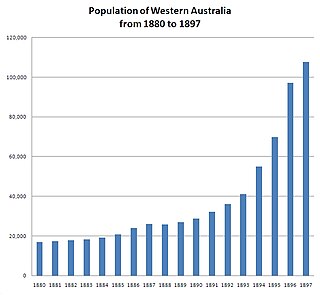
The Nullarbor Plain is part of the area of flat, almost treeless, arid or semi-arid country of southern Australia, located on the Great Australian Bight coast with the Great Victoria Desert to its north. It is the world's largest single exposure of limestone bedrock, and occupies an area of about 200,000 square kilometres (77,000 sq mi). At its widest point, it stretches about 1,100 kilometres (684 mi) from east to west across the border between South Australia and Western Australia.

Wiluna is a small town in the Mid West region of Western Australia. It is situated on the edge of the Western Desert at the gateway to the Canning Stock Route and Gunbarrel Highway. It is the service centre of the local area for the local Martu people, the pastoral industry, the Wiluna Gold Mine, and many more people who work on other mines in the area on a "fly-in/fly-out" basis. Wiluna's climate is hot and dry, with an annual rainfall of 258 millimetres (10.2 in). Mean maximum temperatures range from 19 °C (66 °F) in July, to 38 °C (100 °F) in January.

Dalgaranga crater is a small meteorite impact crater located on Dalgaranga pastoral station 75 km northwest of Mount Magnet in Western Australia. It is only 24 m in diameter and 3 m deep, making it Australia's smallest impact crater. Though discovered in 1921, it was not reported in the scientific literature until 1938. The bedrock at the site is weathered Archaean granite of the Yilgarn Craton. The discovery of fragments of mesosiderite stony-iron meteorite around the crater confirms an impact origin, making this crater unique as the only one known to have been produced by a mesosiderite projectile.

Mount Magnet is one of the Mid West region’s original gold mining towns, and the longest surviving gold mining settlement in Western Australia. The prominent hill that is adjacent to the current townsite was called West Mount Magnet in 1854 by explorer Robert Austin, having named a smaller hill 64 km away, East Mount Magnet. Both hills had an extremely high iron content which affected the readings of his compass. West Mount Magnet had its Aboriginal name reinstated by the Surveyor General in 1972, 'Warramboo," meaning campfire camping place. The magnetic variation at Mount Magnet is zero: magnetic north equals true north.
A pastoral lease, sometimes called a pastoral run, is an arrangement used in both Australia and New Zealand where government-owned Crown land is leased out to graziers for the purpose of livestock grazing on rangelands.

Banjawarn Station is a remote cattle station in Western Australia, that previously operated as a sheep station. In the 1990s Banjawarn was owned by the Aum Shinrikyo, and following the Tokyo subway attack was the subject of an Australian Federal Police (AFP) investigation. Banjawarn is one of the seventy largest stations in Australia.

The Murchison is an interim Australian bioregion located within the Mid West of Western Australia. The bioregion is loosely related to the catchment area of the Murchison River and comprises 281,200 square kilometres (108,600 sq mi). Traditionally the region is known as The Murchison.

Gold mining in Western Australia is the third largest commodity sector in Western Australia, behind iron ore and petroleum, with a value of A$11.9 billion.

In the latter part of the nineteenth century, discoveries of gold at a number of locations in Western Australia caused large influxes of prospectors from overseas and interstate, and classic gold rushes. Significant finds included:

Yundamindera Station is a pastoral lease and sheep station located about 180 kilometres (112 mi) north of Kalgoorlie in the Goldfields-Esperance region of Western Australia.

Mount Celia Station is a pastoral lease and sheep station located about 95 kilometres (59 mi) south of Laverton and 100 kilometres (62 mi) east of Kookynie in the Goldfields-Esperance region of Western Australia.

Melangata Station is a pastoral lease that has operated as a goat transhipment location, as well as sheep station in Western Australia.

Gabyon Station, commonly referred to as Gabyon, is a pastoral lease that operates as a sheep station in Western Australia.

Edjudina Station is a pastoral lease within the Edjudina Land District of Western Australia, that operates as a sheep station. The station is approximately 130 kilometres (80 mi) to the south of Laverton and 240 kilometres (150 mi) north east of Kalgoorlie in the Goldfields-Esperance region. The leasehold shares a boundary with Yundamindera Station.

Laverton Downs Station is a pastoral lease that has operated as both a cattle station and a sheep station in Western Australia.

Erlistoun Station is a pastoral lease that has operated as a cattle station and more recently as a sheep station in Western Australia.

Korong Station was a pastoral lease that operated as a sheep station in Western Australia.

Murnpeowie or Murnpeowie Station is a pastoral lease in outback South Australia. The pastoral lease once operated as a sheep station but now operates as a cattle station. The land occupying the extent of the pastoral lease was gazetted as a locality by the Government of South Australia on 26 April 2013 with the name "Murnpeowie".

Roebuck Plains Station is a pastoral lease that is located close to the township of Broome in the Kimberley region of Western Australia. It is one of the closest pastoral leases to Broome.








